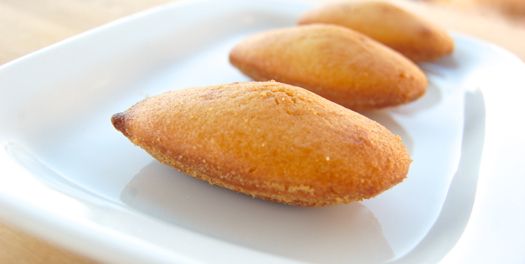Madeleines With a Humpback

I’ve had several requests to show how madeleines can be made with a hump on the back of them, a shape which many consider to be more authentic (whatever that means) than simple, symmetrical clamshell-shaped ones. I personally like those, but who am I to deny my readers?
Getting the hump is all about temperature. The bigger the difference between the batter temperature and the oven temperature, the more pronounced the hump will be. You can get this sort of medium protrusion by chilling your batter for about four hours in the fridge, then panning and baking the batter at the regular 425 Fahrenheit. Chilling the batter in a pastry bag is probably the best way to go here. You can achieve more height by raising the oven temperature.
Why does this work? It’s because the low batter temperature and the high heat causes the madeleine to bake up quickly on the outside. That seals the remaining unbaked batter inside. However as the unbaked batter heats it still needs to expand. Since the rest of the madeleine is now rigid and can’t flex, the interior batter has no choice but to bust out through the top.
I’ve seen madeleines that look like golf balls on the half shell. I have no idea why that’s appealing…but to each their own!
Intellectually, I know that batter’s batter and I’m not getting ‘extra’ cake … but it still looks like extra cake to me. And that’s a plus.
Ha! Never thought of that. Fair enough, Sarvi!
– Joe
Like you Joe, I like my madeleines without the humps. They’re pretty when placing the shell sides up (isn’t that why we paid extra for the pan?). My only issue with madeleines is that the surface of the cake (the flat side) is sticky even when cooled. Is this normal?
Glad to find a fellow spirit on this, Maggie. Exactly…if the back sides are what it’s all about then what’s the flippin’ pan for? Sheesh.
But the sticky surface is a bit of a puzzler. That’s shouldn’t be happening. What recipe are you using?
– Joe
I used the recipe from “Bouchon Bakery” by Thomas Keller (sorry, I haven’t tried your version yet, I will soon). A mixture of honey and brown sugar is added into butter, then melted over medium heat. These madeleines are moist and light everytime. The sticky surface situation, I thought I was underbaked them at first, but even after I overbaked them I still had the same problem. Could it be the honey that cause this?
No problem, Maggie. My recipes certainly aren’t the be-all and end-all! 😉
But yes, that’s the issue. Honey and molasses (which is in brown sugar) stay liquid even after baking. Since syrups tend to rise to the top of batters as they bake, that’s what’s cause the problem. But then maybe it’s a feature of that particular recipe. Still if you want to cut it down the stickiness, swap out granulated sugar for the honey (by weight) to whatever degree you like!
– Joe
Does this work for popovers too ?
Hey Manmita!
Unfortunately no, you wouldn’t want to do that with popover batter since it needs to stay warm and elastic in order to reach its full extension. Very god question though!
– Joe
Thanks for the response Joe. Actually I have been trying to make eggless popovers and I turn to your website whenever I try eggless baking. You mentioned something about gluten in the popover batter in your previous post, may be I should focus on that. Also thank you for all the guidance.
Hello!
Let me know how your experiments go. You should be able to do it with those flaxseed mock eggs. Update me please!
Cheers,
– Joe
I have always used Julia Child’s recipe, which calls for resting the batter before molding and baking the little cakes. Here I thought that the resting part was what caused the hump. Probably, it was resting it in the fridge! I really like the idea of resting this dough in a pastry bag in the fridge. Takes less room. As for the hump on one side and the shell on the other, I just also thought it was a French quirk that I would never understand.
Hey Melinda!
Yes the pastry bag is a handy way to do it, firstly because it takes less space and second because it’s easy to portion the batter that way.
Let me know if you try the technique. I’ll be curious what your results are!
Cheers,
– Joe
Hi Joe,
I wanted to let you know that I referenced your site on my Lemon Thyme Madeleine post. http://www.thefinercookie.com/new-blog-2. Your discussion was so helpful that I felt it only right to credit you.
I have one question for you: I notice that you don’t include baking powder, where many other recipes do. In the end, I chose a recipe with the bp, but I was on the fence about it. How would bp make the madeleine different? Is it just a crutch in case the eggs don’t foam up properly? Hhmm. Just thinking…
Anyway, thank you again for all you do, which is so much.
Kim
The Finer Cookie
And very glad you did too, Kim! Those look great! Wish I’d been there to taste one.
Regarding your question, I think you answered it: the baking powder is there in case the foam doesn’t work. I have nothing against baking powder at all, I just figured my French readers would be all over me if I made that sort of concession to modernity. You know what sticklers they are about tradition! 😉
Thanks again and enjoy those things!
Cheers,
– Joe